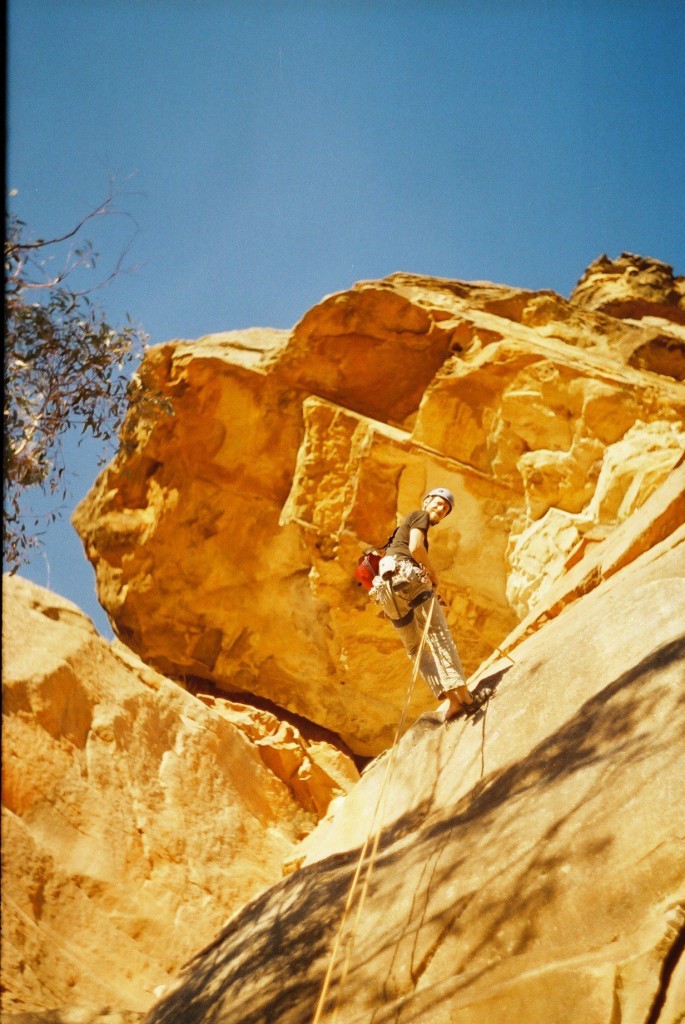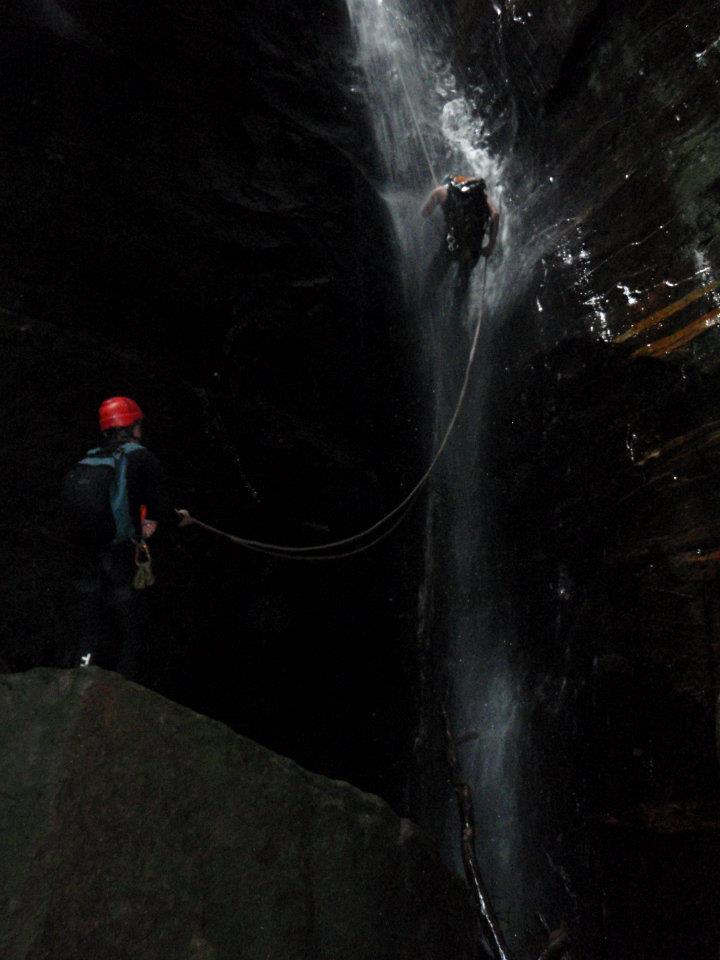It's not good enough to give a new abseiler a descender, clip it into the rope for them, give a thumbs up to your mate down to bottom to confirm he's giving a fireman's belay, and shove them off the cliff. Just keep your feet up! Just keep easing the ropes through your hand!
So here's some best practices for introducing your friend to abseiling, canyoning, or traditional climbing, with some level of safety, backup, and enjoyment.
(The next time I run an instructional day, I'll try to illustrate this post with photos)
Set A Good Example
First up, please be mindful of this. Especially when acting in an official capacity under club insurance. Wear a helmet. And shoes. Avoid unroped scrambling. Don't snack while belaying. Try not to hit on exchange students too blatantly. Address near misses and minor injuries. If you're not going to take it seriously, I'd rather you not teach people.
I hear that during an instructional day this year, some senior members, who should know better, didn't bother with helmets for themselves or the beginners, and were casually leaning over cliff edges and wandering around unroped. Not fucking OK. The next time this happens I will literally slap you. That's a warning.
Personal Equipment
It should go without saying that our newbie should have their own harness, safety tether (e.g. a 120cm nylon sling with a locking carabiner, girth hitched to the belay loop) and belay device.
Don't give people a figure 8 or piton brake, what is this, the 70's? A fiddly fast device like the PFH brake bar thingy, Hydrobot, or any sort of autolocking belay device, is also a bad idea.
For canyoning, give them a rap rack. For climbing, give them an ATC. They might well drop the ATC, so carry a spare or be prepared to give them yours and use a Munter or carabiner brake yourself. (Don't worry too much about them dropping yours as well, if it happens they'll buy you a new one!)
The dangers of long hair and loose clothing should be emphasized.
It's also a bad idea to have them abseiling with a big backpack.
Group Size
Someone who's not confident should definitely have an experienced person at the top and at the bottom of the abseil. So that's a minimum of three people, and two experienced people.
If you must go out with only two people, consider this technique (as an alternative to making the less experienced abseiler lead every pitch while on top belay). Extend the less experienced abseiler's descender with a sling, and put them on rope and check everything. Then, put yourself on rope below them, and go first. With your weight on the rope, their descender will be locked off, while the sling extension will allow them to move out of the way so they don't get pinned with the rope! When you get to the bottom, you can give them a fireman's belay.
Dedicated Instructional Set-up
If you are going to set up an abseil at a cliff with a descent gully somewhere specifically for abseil instruction (e.g. at Mount York or Maroubra Quarry), you can do some things to make it really convenient.
Firstly the anchor should be far enough back from the edge (or far enough above the ledge) to make it easy to grab the rope clip in. Have a big obvious clip-in point or safety line.
Instead of threading the rope through a carabiner or quicklink, tie it off with a Munter-mule hitch. Alternatively, thread it through a belay device and tie it off (a Grigri is plush for lowering, but an ATC works too, and I was actually taught this technique with a figure 8).
Either have a second rope for top belaying, or use the other half of the rope. Extend a power point to the edge, so the belayer can stand or sit there and watch the abseiler, but still belay off the anchor with the device right there.
It's hard to top belay with the abseiler out of sight. Unlike belaying an out-of-sight climber, gravity will pull the belay rope down constantly, making it hard to tell when it's the abseiler pulling, and if you feed out too much slack they'll be a giant loop, and the abseiler will be pressured to speed up!
If the abseiler gets something caught in the device, you can take up the belay rope, lock it off, and then release the mule hitch and lower out the main rope, freeing their belay device. It's also possible to lower them to the ground completely if they freak out.
Field Set-up
Of course, you probably want to get those beginners straight in a canyon or on a climb so they can see what it's all about!
So set up your double-rope abseil through the anchors as normal. Then, you're going to want to tie off both strands, either with a stone knot or a big overhand, as covered in the safer abseiling post.
One experienced person is going to lead the abseil on one strand, and set everything up at the base, before providing a fireman's belay (this is to prevent the abseiler from swinging into a bad position, as well as a backup).
The other strand of rope is going to have a figure 8 on a bight tied in the end, and clipped to the beginner with a locking carabiner. This rope is then put on belay, either on the anchor, or just off the belayer's harness. In either case the belayer should be able to see over the edge and supervise the abseiler as much as possible. The belay provides a backup in case the beginner slips.
Getting over the edge
Always the crux of any abseil, you really need to emphasize the need to sit down and keep the feet high and the bum down. Otherwise they will stand up, slip, and face-plant into the edge. Nasty.
If the anchor is right next to or actually over the edge, you're going to have a bad time. Hopefully you can set up a temporary secondary anchor back from the edge, perhaps off a useful tree.
Lowering and Tandem Rappelling
If the beginner decides they don't want to do any more abseiling, that's OK. However, if there's still a rope length or more between them and the ground, that's a problem!
If you want to lower them, it's probably best to use an ATC device re-directed through the anchor. Auto-locking setups tend to have finicky releases and can and do result in accidentents. Lowering is probably a better option for a short and narrow overhung canyon chockstone abseil.
Another option is to clip them into the same belay device as an experienced abseiler, and have them tandem rappel. Tandem rappeling is probably a better option for an exposed wall, where the abseiling is easy and the psychological support will be a huge benefit.
Conclusion
It's easy to forget how scary and intimidating cliffs can be, and how little trust you initially have in the rope. People do slip, trip, choke, and let go of the rope. A bomber anchor and top rope will make it obviously safe, and a reassured beginner will have more fun and make less mistakes. Make the effort and do it right!





